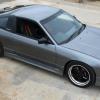All the Rumors aside **Nissan Patrol Clutch fits**
Announcements
-
Similar Content
-
Latest Posts
-
Yep that's pretty much what I want to see. Racecars that look and sound like the Group A but with newer tech underneath to make them faster and safer. I'm sure there's enough VK-to-VN commodore, E30 BMWs and Foxbody mustangs shells around to make up a decent number of cars with hopefully a couple of sierras, rx7 and R31s in there too.
-
By robbo_rb180 · Posted
Contact Jessestreeter.com/Skevas Racing/JustJap for a new r34 rb gearbox or go a cd00# conversion. No point playing with unknown condition gearboxes. -
By robbo_rb180 · Posted
Such a shame places like Amaroo Park have been redeveloped, smaller tracks always make for good racing. Cheers for sharing @PranK there's some good Lakeside video's too. Its so hard with older the cars as parts are so rare and everything was made for a particular chassis at that point in time. Even the V8 Supercar Blueprint era cars are all different between each chassis within a team as they learnt things and made improvements. The COTF cars between each Chassis builder is different too especially motor/oil systems/intakes. The Group A stuff is worth so much too especially chassis with good history. The only way to do it would be composite panels and similar engine drivelines to the original cars. Ford sierra running Focus RS driveline, Commodore running a short stroke LS/LT or a Falcon with coyote and a H Pattern dog box. Could use a standard ecu across all models with a Torque Map and DBW for parity which is not even used in Supercars currently. Hell a TCM is almost a full chassis car these days and the suspension is not even close to standard style in the front running cars. -
Dashcams Australia (13/05/25) captured JDMHSE (Vic plate) being a right tosser.
-
Wish someone would start a racing series for Group A replica cars, a bit like Touring Car Masters but for 1985 onwards and not grandpa's falcon and/or Monaro. I know they race in some historic class but that's for original cars, no replicas allowed.
-








Recommended Posts
Create an account or sign in to comment
You need to be a member in order to leave a comment
Create an account
Sign up for a new account in our community. It's easy!
Register a new accountSign in
Already have an account? Sign in here.
Sign In Now